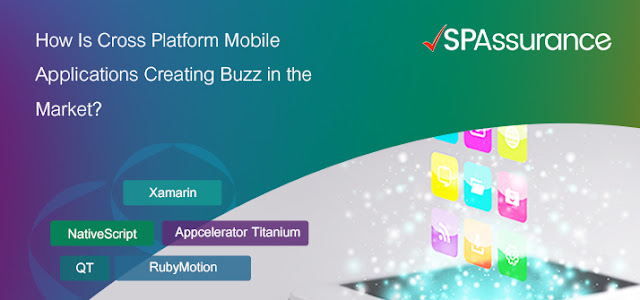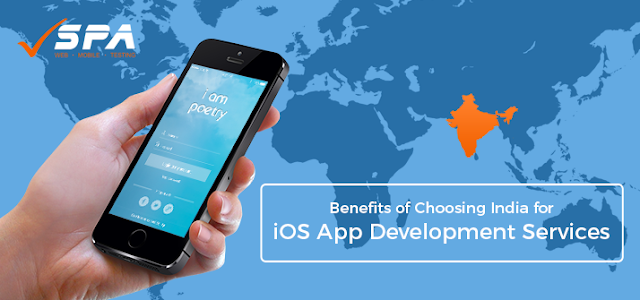How Is Cross Platform Mobile Applications Creating Buzz in the Market?
Cross platform mobile app development or hybrid app development is the talk of the town nowadays. This kind of apps can be run on different platform hence it needs a single coding which not only saves time to the market but also save money of the businesses.
One challenging situation for mobile app developers is, whether to create a native mobile app or go for the cross-platform mobile app development. Of course, as a business, you need dealing with different types of clients who possess different types of devices. Therefore, you would need to have a mobile application that could work seamlessly on almost all the platforms (i.e. Android, iOS, Windows, etc.)
What are cross-platform mobile apps?
In ideal scenario, cross-platform mobile apps work on multiple operating systems with a single code base. There are 2 types of cross-platform apps:
Native Cross-Platform Apps
All major operating system of smartphones has its own SDK (Software Development Kit) to create mobile apps. These SDKs also have preferred programming languages which are supported by the OS vendor. For example, for iOS, Objective-C and Swift are the preferred programming languages supported by Apple, whereas for Android, Java is the preferred language supported by Google. Generally, apps created with these languages using the official SDK are called as “native apps”.
Furthermore, it is possible to use APIs (Application Programming Interface) provided by the native SDK, in other programming languages which are not supported by the operating system vendor. “cross-platform” native mobile apps are created in the same manner.
Generally, a third party vendor chooses a programming language and creates a unified API on top of the native SDKs provided by the various OS vendors. Using this unified API, it is possible to support multiple operating systems with a single code base. The third-party vendor generally provides an IDE (Integrated Development Environment) which handles the process of creating the native application bundle for iOS and Android from the single cross-platform codebase.
Since, the final app produced still uses the native APIs, the cross-platform native apps can achieve near native performance without any visible lag to the user.
Current State of Implementation
Though creating cross-platform native applications is possible today, the current state of implementation is far from complete. Most of the mobile apps are heavy on the GUI (Graphical User Interface) implementation side. Almost all the critical business application logic resides on the server which is accessed by the mobile via web services.
Since the User Interface (UI) and User Experience Design (UXD) of iOS and Android are quite different from each other, it’s not an easy task to create a uniform GUI wrapper on top of it. Though Xamarin and others have put in significant work on this front, it is far from perfect. It works well if you design your application to live within the framework limitation, however, if you need anything that doesn’t fit with the framework’s vision, it requires a lot of work to implement and requires writing platform specific code.
To give you an example, in Xamarin Forms, it takes a lot more work if your designer chooses to give custom colored borders to text fields. As this is not obvious to the designer, once you have settled in on the design, the programming team needs to put in a lot of efforts to pull off this seemingly simple design. Xamarin is working hard to provide more advanced cross-platform UI components under their Xamarin Forms Labs project. But many components of this project are still under beta status.
One popular approach taken in native cross-platform development involves writing business logic and web service calls using cross-platform libraries while GUI related code is written with platform specific libraries. Depending on the application, this can allow 30% to 60% code reuse.
Popular Native Cross-Platform Frameworks:
1. Xamarin: A California-based software company, which now is backed by Microsoft, founded in 2011. Xamarin uses C# as the main language for the cross-platform development. C# is a statically typed language with mature tooling and IDE support. Also, many big companies have C# programmers already in their in-house IT departments. So, enterprises tend to regard Xamarin as a good investment.
2. Appcelerator Titanium: One of the earliest players in this domain. They launched iOS support in 2009 while Android support was added in 2012. Appcelerator Titanium uses JavaScript as the main language for development and aims at bringing familiar web development paradigms to native mobile application development. However, it somehow didn’t capture the mainstream attention but lots of applications development is happening on top of it. Appcelerator also has a proprietary paid MBaaS (Mobile Backend as a Service), which it is pushing more. In the early days, Titanium had quite a few issues which were discussed widely in the blogosphere. This may also have hampered its adoption.
3. NativeScript: Like Titanium, NativeScript aims at making web-like programming available to app development. NativeScript was announced by Telerik, a company which is famous for its suite of GUI components for enterprise applications in 2014. It uses JavaScript as the main development language. Native script also supports TypeScript, Angular and uses CSS for styling. Compared to the other technologies mentioned above, NativeScript is relatively new but it has a lot of potential.
4. QT: QT is one of the oldest cross-platform desktop development libraries around, released 21 years ago, in the year 1995. They added support for cross-platform iOS and Android applications in 2013. QT uses C++ along with QML (Qt Meta Language or Qt Modeling Language- it’s a markup language similar to HTML) to create cross-platform applications. However, QT GUI components, by default, don’t follow the look and feel of iOS and Android. Also, C++ is not an easy programming language because of its huge syntax, manual memory management and standards compatibility issues. However, in the hands of experienced C++ programmers, QT can be quite productive.
5. RubyMotion: RubyMotion is the main language for the development. One of the early players in this domain. When first announced in 2012, it was for iOS only, but supports both iOS and Android, since 2014. Rubymotion requires separate GUI code for iOS and Android, however, business logic can be reused across-platforms.
To read more related to Hybrid mobile app development services please go through: www.sp-assurance.com/blogs
One challenging situation for mobile app developers is, whether to create a native mobile app or go for the cross-platform mobile app development. Of course, as a business, you need dealing with different types of clients who possess different types of devices. Therefore, you would need to have a mobile application that could work seamlessly on almost all the platforms (i.e. Android, iOS, Windows, etc.)
What are cross-platform mobile apps?
In ideal scenario, cross-platform mobile apps work on multiple operating systems with a single code base. There are 2 types of cross-platform apps:
- Native Cross-Platform Apps
- Hybrid ‘HTML5’ Cross-Platform Apps
Native Cross-Platform Apps
All major operating system of smartphones has its own SDK (Software Development Kit) to create mobile apps. These SDKs also have preferred programming languages which are supported by the OS vendor. For example, for iOS, Objective-C and Swift are the preferred programming languages supported by Apple, whereas for Android, Java is the preferred language supported by Google. Generally, apps created with these languages using the official SDK are called as “native apps”.
Furthermore, it is possible to use APIs (Application Programming Interface) provided by the native SDK, in other programming languages which are not supported by the operating system vendor. “cross-platform” native mobile apps are created in the same manner.
Generally, a third party vendor chooses a programming language and creates a unified API on top of the native SDKs provided by the various OS vendors. Using this unified API, it is possible to support multiple operating systems with a single code base. The third-party vendor generally provides an IDE (Integrated Development Environment) which handles the process of creating the native application bundle for iOS and Android from the single cross-platform codebase.
Since, the final app produced still uses the native APIs, the cross-platform native apps can achieve near native performance without any visible lag to the user.
Current State of Implementation
Though creating cross-platform native applications is possible today, the current state of implementation is far from complete. Most of the mobile apps are heavy on the GUI (Graphical User Interface) implementation side. Almost all the critical business application logic resides on the server which is accessed by the mobile via web services.
Since the User Interface (UI) and User Experience Design (UXD) of iOS and Android are quite different from each other, it’s not an easy task to create a uniform GUI wrapper on top of it. Though Xamarin and others have put in significant work on this front, it is far from perfect. It works well if you design your application to live within the framework limitation, however, if you need anything that doesn’t fit with the framework’s vision, it requires a lot of work to implement and requires writing platform specific code.
To give you an example, in Xamarin Forms, it takes a lot more work if your designer chooses to give custom colored borders to text fields. As this is not obvious to the designer, once you have settled in on the design, the programming team needs to put in a lot of efforts to pull off this seemingly simple design. Xamarin is working hard to provide more advanced cross-platform UI components under their Xamarin Forms Labs project. But many components of this project are still under beta status.
One popular approach taken in native cross-platform development involves writing business logic and web service calls using cross-platform libraries while GUI related code is written with platform specific libraries. Depending on the application, this can allow 30% to 60% code reuse.
Popular Native Cross-Platform Frameworks:
1. Xamarin: A California-based software company, which now is backed by Microsoft, founded in 2011. Xamarin uses C# as the main language for the cross-platform development. C# is a statically typed language with mature tooling and IDE support. Also, many big companies have C# programmers already in their in-house IT departments. So, enterprises tend to regard Xamarin as a good investment.
2. Appcelerator Titanium: One of the earliest players in this domain. They launched iOS support in 2009 while Android support was added in 2012. Appcelerator Titanium uses JavaScript as the main language for development and aims at bringing familiar web development paradigms to native mobile application development. However, it somehow didn’t capture the mainstream attention but lots of applications development is happening on top of it. Appcelerator also has a proprietary paid MBaaS (Mobile Backend as a Service), which it is pushing more. In the early days, Titanium had quite a few issues which were discussed widely in the blogosphere. This may also have hampered its adoption.
3. NativeScript: Like Titanium, NativeScript aims at making web-like programming available to app development. NativeScript was announced by Telerik, a company which is famous for its suite of GUI components for enterprise applications in 2014. It uses JavaScript as the main development language. Native script also supports TypeScript, Angular and uses CSS for styling. Compared to the other technologies mentioned above, NativeScript is relatively new but it has a lot of potential.
4. QT: QT is one of the oldest cross-platform desktop development libraries around, released 21 years ago, in the year 1995. They added support for cross-platform iOS and Android applications in 2013. QT uses C++ along with QML (Qt Meta Language or Qt Modeling Language- it’s a markup language similar to HTML) to create cross-platform applications. However, QT GUI components, by default, don’t follow the look and feel of iOS and Android. Also, C++ is not an easy programming language because of its huge syntax, manual memory management and standards compatibility issues. However, in the hands of experienced C++ programmers, QT can be quite productive.
5. RubyMotion: RubyMotion is the main language for the development. One of the early players in this domain. When first announced in 2012, it was for iOS only, but supports both iOS and Android, since 2014. Rubymotion requires separate GUI code for iOS and Android, however, business logic can be reused across-platforms.
To read more related to Hybrid mobile app development services please go through: www.sp-assurance.com/blogs




Comments
Post a Comment